The Organic Acai Juice Market is estimated to be valued at USD 693.7 million in 2025 and is projected to reach USD 1799.2 million by 2035, registering a compound annual growth rate (CAGR) of 10.0% over the forecast period.
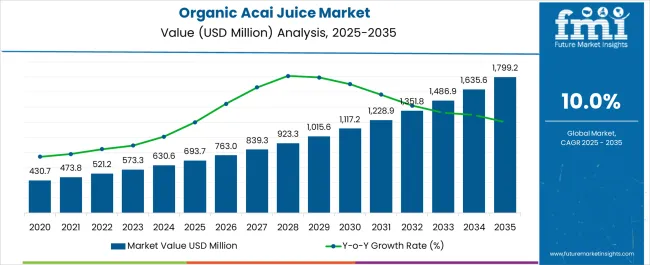
| Metric | Value |
|---|---|
| Organic Acai Juice Market Estimated Value in (2025 E) | USD 693.7 million |
| Organic Acai Juice Market Forecast Value in (2035 F) | USD 1799.2 million |
| Forecast CAGR (2025 to 2035) | 10.0% |
The Organic Acai Juice market is expanding steadily, supported by the growing consumer shift toward functional beverages and clean-label nutrition. Increasing health consciousness among consumers, particularly in urban populations, has accelerated the adoption of acai-based beverages due to their antioxidant-rich composition, high nutrient value, and immunity-boosting properties. Rising demand from fitness enthusiasts and wellness-driven consumers is further propelling market growth.
Organic positioning is playing a pivotal role as consumers increasingly prefer products free from synthetic additives, pesticides, and genetically modified ingredients. The market is also benefiting from product diversification efforts by manufacturers who are introducing flavored blends and ready-to-drink variants to cater to a wide range of taste preferences. In addition, e-commerce channels and expanding retail presence are ensuring higher accessibility across both developed and developing regions.
Strategic investments in sustainable sourcing and transparent supply chains are strengthening consumer trust and brand value With wellness trends continuing to influence purchasing behavior, the Organic Acai Juice market is projected to remain on a strong growth trajectory, with heightened adoption in both household and institutional sectors over the coming years.
The organic acai juice market is segmented by end use, distribution channel, packaging type, and geographic regions. By end use, organic acai juice market is divided into HoReCa and Household. In terms of distribution channel, organic acai juice market is classified into Direct and Indirect. Based on packaging type, organic acai juice market is segmented into Sterile Filled Bag-In-Box, Plastic Drum, Plastic Container, Stainless Steel Container, and Steel Drum. Regionally, the organic acai juice industry is classified into North America, Latin America, Western Europe, Eastern Europe, Balkan & Baltic Countries, Russia & Belarus, Central Asia, East Asia, South Asia & Pacific, and the Middle East & Africa.
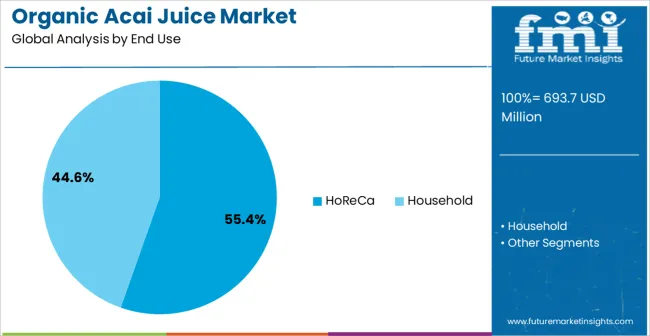
The HoReCa segment is anticipated to account for 55.4% of the Organic Acai Juice market’s revenue share in 2025, making it the leading end-use category. Growth in this segment is being driven by the increasing consumption of acai-based beverages in hotels, restaurants, and cafés, where health-oriented menus are gaining prominence. HoReCa establishments are actively incorporating organic juices into their offerings to meet the rising demand for nutritious and exotic beverages.
The segment also benefits from bulk purchasing practices, which enhance sales volumes and strengthen distribution partnerships with suppliers. Growing consumer preference for dining experiences that integrate wellness with indulgence is further reinforcing the use of Organic Acai Juice in premium establishments. Seasonal promotions, custom blends, and functional beverage innovations are expanding its presence in the segment.
Additionally, partnerships between juice manufacturers and HoReCa outlets are improving brand visibility and product reach As urban lifestyles drive higher frequency of dining out, the segment’s leadership is expected to persist, fueled by the continuous expansion of the hospitality and food service industries globally.
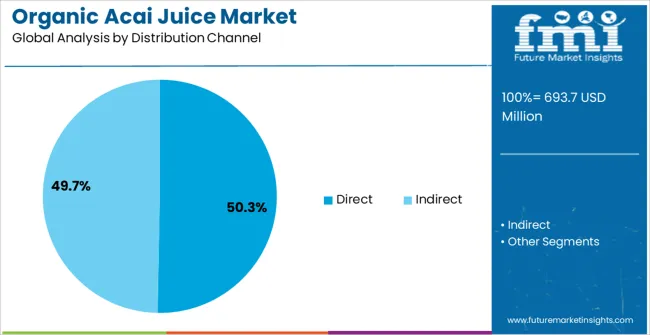
The direct distribution channel is projected to hold 50.3% of the Organic Acai Juice market revenue share in 2025, highlighting its dominance in product accessibility. Direct sales allow manufacturers to establish stronger customer relationships by offering competitive pricing and customized product options, reducing reliance on intermediaries. Increasing adoption of online direct-to-consumer platforms is transforming the distribution landscape, providing convenient access and transparent communication for health-conscious buyers.
The segment benefits from higher margins, as brands can bypass traditional retail markups and simultaneously capture consumer feedback for product improvements. Additionally, health and wellness subscription services are leveraging direct distribution to deliver acai juice regularly to consumers, enhancing loyalty and repeat purchases.
Food service operators and institutional buyers also rely heavily on direct procurement to ensure freshness and quality consistency, strengthening the segment’s position With e-commerce penetration accelerating globally and direct sales strategies offering both efficiency and customer engagement, this channel is expected to remain the preferred mode of distribution, further consolidating its leadership in the Organic Acai Juice market.
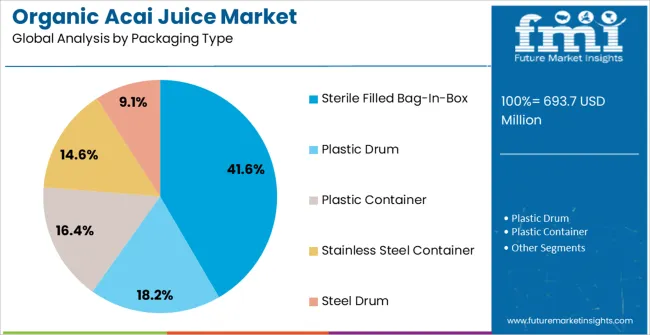
The sterile filled bag-in-box packaging segment is expected to secure 41.6% of the Organic Acai Juice market revenue share in 2025, making it the leading packaging format. This dominance is supported by its suitability for bulk storage and extended shelf-life preservation, which is highly valued by institutional buyers and large-scale food service operators. The packaging ensures aseptic conditions that protect the juice from contamination while maintaining nutritional integrity and flavor.
Cost-effectiveness and ease of transportation further contribute to its preference, particularly for businesses requiring consistent supply volumes. The format also supports sustainability goals, as bag-in-box systems use less material compared to traditional bottles, reducing environmental impact. HoReCa outlets are increasingly adopting this packaging to meet high demand efficiently without compromising product quality.
Manufacturers are leveraging sterile bag-in-box solutions to cater to both domestic and international markets, given their suitability for long-distance shipments As efficiency, cost savings, and sustainability become critical priorities, the sterile filled bag-in-box segment is anticipated to sustain its leadership role, driving continued innovation in large-scale organic juice packaging solutions.
Organic Acai Juice, as the name suggests, is the juice obtained from organically cultivated acai berry fruit, which consists of exceptional nutritional quality and is one of the most popular super-fruit. Organic acai juice is a certified USDA product consisting of a single serving of fruit.
Organic acai juice involves the absence of artificial flavors and presence of acai berries which are grown and gathered from their natural and native habitat, in an eco-friendly manner. This indirectly means that there should not be any involvement of man-made chemical or unnatural interventions, herbicides or pesticides.
Organic acai juice does offer health benefits, due to some features associated with its source that is acai berry, including resists harmful organisms, aids consumers in weight loss, helps in digestion, reduces irritation in the lungs, improves brain functioning, boosts energy, and much more.
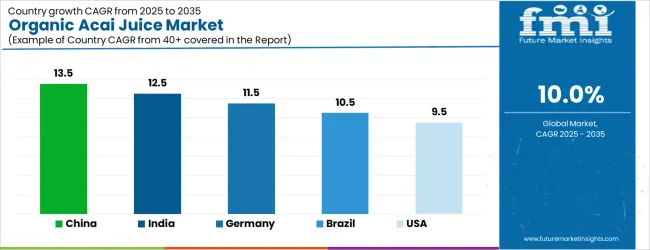
| Country | CAGR |
|---|---|
| China | 13.5% |
| India | 12.5% |
| Germany | 11.5% |
| Brazil | 10.5% |
| USA | 9.5% |
| UK | 8.5% |
| Japan | 7.5% |
The Organic Acai Juice Market is expected to register a CAGR of 10.0% during the forecast period, exhibiting varied country level momentum. China leads with the highest CAGR of 13.5%, followed by India at 12.5%. Developed markets such as Germany, France, and the UK continue to expand steadily, while the USA is likely to grow at consistent rates. Japan posts the lowest CAGR at 7.5%, yet still underscores a broadly positive trajectory for the global Organic Acai Juice Market.
In 2024, Germany held a dominant revenue in the Western Europe market and is expected to grow with a CAGR of 11.5%. The USA Organic Acai Juice Market is estimated to be valued at USD 246.4 million in 2025 and is anticipated to reach a valuation of USD 246.4 million by 2035. Sales are projected to rise at a CAGR of 0.0% over the forecast period between 2025 and 2035. While Japan and South Korea markets are estimated to be valued at USD 34.3 million and USD 21.5 million respectively in 2025.
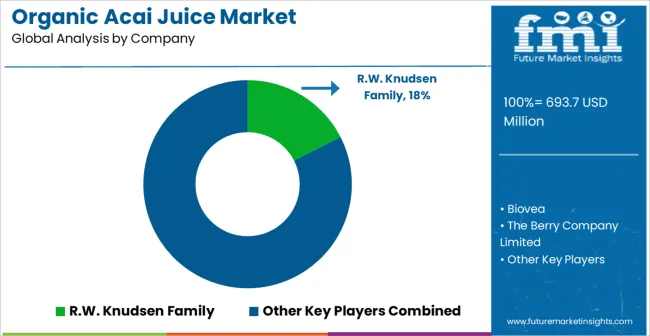
| Item | Value |
|---|---|
| Quantitative Units | USD 693.7 Million |
| End Use | HoReCa and Household |
| Distribution Channel | Direct and Indirect |
| Packaging Type | Sterile Filled Bag-In-Box, Plastic Drum, Plastic Container, Stainless Steel Container, and Steel Drum |
| Regions Covered | North America, Europe, Asia-Pacific, Latin America, Middle East & Africa |
| Country Covered | United States, Canada, Germany, France, United Kingdom, China, Japan, India, Brazil, South Africa |
| Key Companies Profiled | R.W. Knudsen Family, Biovea, The Berry Company Limited, Zola, ambazon, Inc., Organique Acai USA, Acai Roots, Inc., Nossa Fruits, Açaí Berry Foods, and Organic Rainforest Company |
The global organic acai juice market is estimated to be valued at USD 693.7 million in 2025.
The market size for the organic acai juice market is projected to reach USD 1,799.2 million by 2035.
The organic acai juice market is expected to grow at a 10.0% CAGR between 2025 and 2035.
The key product types in organic acai juice market are horeca and household.
In terms of distribution channel, direct segment to command 50.3% share in the organic acai juice market in 2025.






Our Research Products

The "Full Research Suite" delivers actionable market intel, deep dives on markets or technologies, so clients act faster, cut risk, and unlock growth.

The Leaderboard benchmarks and ranks top vendors, classifying them as Established Leaders, Leading Challengers, or Disruptors & Challengers.

Locates where complements amplify value and substitutes erode it, forecasting net impact by horizon

We deliver granular, decision-grade intel: market sizing, 5-year forecasts, pricing, adoption, usage, revenue, and operational KPIs—plus competitor tracking, regulation, and value chains—across 60 countries broadly.

Spot the shifts before they hit your P&L. We track inflection points, adoption curves, pricing moves, and ecosystem plays to show where demand is heading, why it is changing, and what to do next across high-growth markets and disruptive tech

Real-time reads of user behavior. We track shifting priorities, perceptions of today’s and next-gen services, and provider experience, then pace how fast tech moves from trial to adoption, blending buyer, consumer, and channel inputs with social signals (#WhySwitch, #UX).

Partner with our analyst team to build a custom report designed around your business priorities. From analysing market trends to assessing competitors or crafting bespoke datasets, we tailor insights to your needs.
Supplier Intelligence
Discovery & Profiling
Capacity & Footprint
Performance & Risk
Compliance & Governance
Commercial Readiness
Who Supplies Whom
Scorecards & Shortlists
Playbooks & Docs
Category Intelligence
Definition & Scope
Demand & Use Cases
Cost Drivers
Market Structure
Supply Chain Map
Trade & Policy
Operating Norms
Deliverables
Buyer Intelligence
Account Basics
Spend & Scope
Procurement Model
Vendor Requirements
Terms & Policies
Entry Strategy
Pain Points & Triggers
Outputs
Pricing Analysis
Benchmarks
Trends
Should-Cost
Indexation
Landed Cost
Commercial Terms
Deliverables
Brand Analysis
Positioning & Value Prop
Share & Presence
Customer Evidence
Go-to-Market
Digital & Reputation
Compliance & Trust
KPIs & Gaps
Outputs
Full Research Suite comprises of:
Market outlook & trends analysis
Interviews & case studies
Strategic recommendations
Vendor profiles & capabilities analysis
5-year forecasts
8 regions and 60+ country-level data splits
Market segment data splits
12 months of continuous data updates
DELIVERED AS:
PDF EXCEL ONLINE
Organic Cosmetics Market Size and Share Forecast Outlook 2025 to 2035
Organic Salad Dressing Market Forecast and Outlook 2025 to 2035
Organic Fertilizer Market Size and Share Forecast Outlook 2025 to 2035
Organic Beverages Market Size and Share Forecast Outlook 2025 to 2035
Organic Drinks Market Size and Share Forecast Outlook 2025 to 2035
Organic Oats Market Size and Share Forecast Outlook 2025 to 2035
Organic Dried Distillers Grain Feed Market Size and Share Forecast Outlook 2025 to 2035
Acai Berry Extracts Market Analysis - Size and Share Forecast Outlook 2025 to 2035
Organic Hemp Market Size and Share Forecast Outlook 2025 to 2035
Organic Electronics Market Size and Share Forecast Outlook 2025 to 2035
Organic Dyes Market Size and Share Forecast Outlook 2025 to 2035
Organic Rankine Cycle Market Size and Share Forecast Outlook 2025 to 2035
Juice Extraction Equipment Market Size and Share Forecast Outlook 2025 to 2035
Organic Seed Varieties Market Size and Share Forecast Outlook 2025 to 2035
Organic Lamb Market Size and Share Forecast Outlook 2025 to 2035
Organic Snack Food Market Size and Share Forecast Outlook 2025 to 2035
Organic Rice Protein Market Size and Share Forecast Outlook 2025 to 2035
Organic Hydrosols Market Size and Share Forecast Outlook 2025 to 2035
Acai Berry Market Size, Growth, and Forecast for 2025 to 2035
Organic Trace Minerals Market Analysis - Size, Share, and Forecast Outlook 2025 to 2035

Thank you!
You will receive an email from our Business Development Manager. Please be sure to check your SPAM/JUNK folder too.
Chat With
MaRIA